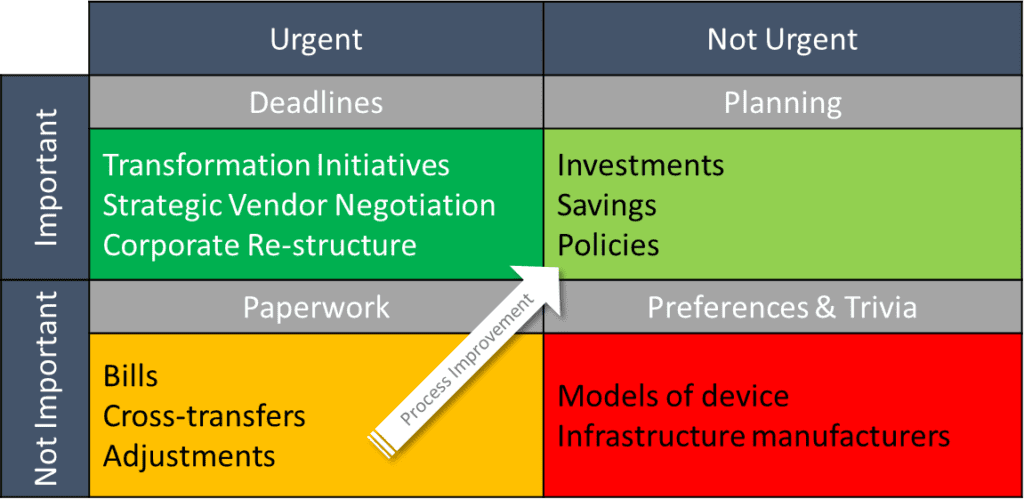A change happens in the last few days in December. Some sectors are in the middle of the busiest time of their year, many have just enjoyed a rare few days where the pace of business slackens or even stops, as we remind our families what our faces actually look like in the flesh. Even for the busy ones, the media have been putting out a constant stream of reviews of the best and worst of 2014. We have had a chance to reflect on the year just gone, and now we start gearing up for the year ahead.
I’ve an assortment of projects and planning ideas sketched out in my trusty OneNote notebook. I can also look through the meetings, planning sessions and customer visits already in my diary for January and see there’s plenty of other organizations in the process of settling important decisions that will impact their business for the next year or three.
What is important, though? This brief, annual pause in the business cycle is a perfect time to realize the truth behind Eisenhower’s old maxim: “What is important is seldom urgent and what is urgent is seldom important.” This is often represented as the perennial favorite below, the Eisenhower Matrix:

An Eisenhower Matrix for IT Financial Management
Your mileage may vary, but I think most will recognize something of their working environment in the way I’ve filled out the matrix from an IT Financial Management (ITFM) perspective. It explains a particular challenge: important work must get done, but urgent work gets in the way. Even in our personal lives, we’re familiar with how paying the bills and hunting for a good deal can distract us from reviewing longer term matters such as savings plans and pension arrangements.
There are three main lessons for ITFM that you can take from the matrix above. These revolve around the benefits of moving along the “Process Improvement” arrow I’ve laid over the grid:
- A good process will give you more time to focus on better, higher value decisions
- Don’t let your team get mired in trivia about specific devices or vendors
- Performance at critical moments depends on planning ahead, e.g. for negotiations
2015 will see a number of trends continue in enterprise technology. Lines of business and other corporate functions will continue to grow in confidence that they should own their own budget for technology. CEOs will continue to have rising expectations of what “digital business” means for their company. Pressure will not let up on government departments to be able to track their expenditure on major initiatives.
Just as the heads of other functions are focused on their strategic goals, IT and IT Finance likewise should ensure their team is focused on what is important. Your team’s real priorities aren’t necessarily what they are supposed to be. Based on the matrix, here’s a quick self-assessment you can perform of your organization’s real priorities:
- How much time does your IT finance team spend on finding value opportunities, compared to simply keeping up with the paperwork for tracking and allocating costs?
- How much of your relationship with other business units is spent on planning and delivering new capabilities, compared to explaining the details of cross-charges and procurement decisions?
- When you sit down to review major contracts, re-orgs or the impact of M&A activity, do you feel comfortable that you have a good understanding of your cost structure?
What I often find at the start of an ITFM related initiative is that a financial process is in place, and running smoothly – but that the overall priorities, as measured by where the team spends their time, are as much about Excel maintenance as they are about business improvements.
The regular urgency to perform cost allocations and keep spreadsheets up to date can be a major distraction from actually getting things done. It is deadline-driven and urgent, but it is not important. It has to be done, but it does not have to be done by you.
That’s why at ComSci, we talk a lot about Business Process as a Service. For us, the day-to-day heavy lifting of running an effective, data-driven chargeback or showback process is important. It is our commercial purpose; it is our revenue stream. We work hard to make sure that our processes and technology are scalable. Our dedicated production team can handle significantly more systems and transactions, at lower cost and higher quality, than IT Finance teams that typically have cost allocation as a secondary responsibility.
Our customers enjoy more time to focus on what it is truly important to their company, while ITFM becomes a source of value rather than a sinkhole for time. Easy access to regular, reliable cost and billing information helps manage the challenges specific to their business: big ticket “one-offs”, such as major initiatives or negotiations, and the ongoing improvement of their service portfolio. And with good information being provided on a regular, colleagues are far less likely to start those conversations which devolve in to discussions about relatively trivial technology preferences.
Of course, every business has its own unique requirements. We’d love to help by easing your administrative load and revealing new information about your operations. When you look at the changes to come in your organization in 2015, what’s important to you?

